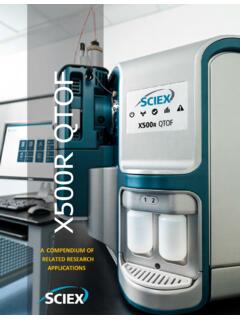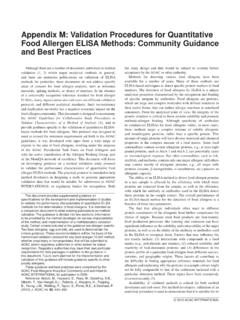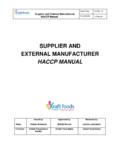Transcription of Contents
1 Contents List of Figures .. iv List of v Acknowledgements .. vi Foreword .. vii Abbreviations .. viii Explanatory note .. x 1. Introduction .. 1. 2. Factors affecting the constitution of mycotoxin regulations in food and feed .. 3. Hazard identification and hazard 3. Exposure 4. Sampling 5. Methods of analysis .. 6. Trade contacts .. 7. Food 8. Synopsis .. 8. 3. mycotoxin regulations in 2003 and current 9. The international inquiry from 2002 to 9. General 9. Specific observations per region .. 10. 10. Asia/Oceania .. 12. Europe .. 14. Latin 15. North 16. Specific observations per mycotoxin or group of 17. Worldwide limits for aflatoxins .. 17. Worldwide limits for other mycotoxins .. 23. Harmonized regulations .. 27. Australia/New 27. European 27. 27. ASEAN .. 28. Codex 28. 4. Concluding remarks.
2 29. References .. 31. Annex 1: Contributions .. 37. Annex 2: Tables .. 43. iii Figures Figure 1: Countries with and without regulations for mycotoxins Figure 2: Percentages of world's inhabitants covered by mycotoxin regulations Figure 3: Mycotoxins regulated in food in Africa Figure 4: Mycotoxins regulated in feed in Africa Figure 5: Mycotoxins regulated in food in Asia/Oceania Figure 6: Mycotoxins regulated in feed in Asia/Oceania Figure 7: Mycotoxins regulated in food in Europe Figure 8: Mycotoxins regulated in feed in Europe Figure 9: Mycotoxins regulated in food in Latin America Figure 10: Mycotoxins regulated in feed in Latin America Figure 11: Mycotoxins regulated in food in North America Figure 12: Mycotoxins regulated in feed in North America Figure 13: Worldwide limits for aflatoxin B1 in food Figure 14.
3 Worldwide limits for total aflatoxins in food Figure 15: Ranges and medians of limits for total aflatoxins in food per world region Figure 16: Worldwide limits for aflatoxin M1 in milk Figure 17: Worldwide limits for aflatoxin B1 in feed for dairy cattle Figure 18: Worldwide limits for total aflatoxins in feed for dairy cattle Figure 19: Worldwide limits for patulin in fruits and fruit juices Figure 20: Worldwide limits for ochratoxin A in cereals and cereal products Figure 21: Worldwide limits for deoxynivalenol in wheat (flour) and other cereals Figure 22: Worldwide limits for zearalenone in maize and other cereals Figure 23: Worldwide limits for fumonisins in maize iv Tables Table 1: Overview of currently available mycotoxin reference materials 43. Table 2: Overview of countries involved in the mycotoxins survey (2002 to 2003) 45.
4 Table 3: Maximum tolerated levels of mycotoxins in foodstuffs, dairy products and 47. animal feedstuffs (2002-2003 survey). Table 4: Medians and ranges in 1995 and 2003 of maximum tolerated levels (ng/g) for 165. some (groups of) aflatoxins and numbers of countries with relevant regulations v Acknowledgements This study was conducted by the Laboratory for Food and Residue Analyses (ARO) of the National Institute for Public Health and the Environment, the Netherlands, under contract with FAO. The work was also undertaken by ARO as a part of its duties as European Union (EU) Community Reference Laboratory for Residues (CRL). FAO wishes to acknowledge the valuable work of the authors, Van Egmond and Jonker, ARO, as well as all countries that contributed by collecting and supplying valuable information for this document.
5 A detailed list of contributing institutions and persons is provided in Annex 1. vi Foreword Since the discovery of the aflatoxins in the 1960s, regulations have been established in many countries to protect consumers from the harmful effects of mycotoxins that may contaminate foodstuffs, as well as to ensure fair practices in food trade. Various factors play a role in decision-making processes focused on setting limits for mycotoxins. These include scientific factors to assess risk (such as the availability of toxicological data), food consumption data, knowledge about the level and distribution of mycotoxins in commodities, and analytical methodology. Economic factors, such as commercial and trade interests and food security issues, also have an impact. Weighing the various factors that play a role in the decision- making process to establish mycotoxin tolerances is therefore of crucial importance.
6 Despite the difficulties, mycotoxin regulations have been established in many countries during the past decades, and newer regulations are still being issued. National regulations have been established for a number of mycotoxins such as the naturally occurring aflatoxins and aflatoxin M1; the trichothecenes deoxynivalenol, diacetoxyscirpenol, T-2 toxin and HT-2. toxin, the fumonisins B1, B2 and B3; agaric acid; the ergot alkaloids; ochratoxin A; patulin, phomopsins; sterigmatocystin and zearalenone. International inquiries on existing legislation on mycotoxins in foodstuffs and animal feedstuffs have been carried out several times, and details about tolerance levels, legal bases, responsible authorities, and official protocols for sampling and analysis have been published. The Food and Agriculture Organization of the United Nations (FAO) has played a major role in providing information on worldwide regulations for mycotoxins in foods and feeds.
7 The last comprehensive overview on worldwide regulations was published as the FAO Food and Nutrition Paper 64 in 1997. At that time, 77 countries had specific regulations for mycotoxins in different foods and feeds and 13 countries had general provisions, while about 50 countries did not have data available. The number of countries with specific regulations for mycotoxins has increased over the years. This reflects the general concern that governments have about the potential effects of mycotoxins on humans and animal health and their implications for trade. The present publication updates the information in the FAO Food and Nutrition Paper 64 and describes the situation of worldwide mycotoxin regulations as of December 2003, based on an international inquiry that was carried out in 2002 and 2003.
8 Vii Abbreviations AFB1 Aflatoxin B1. AFBI/G1 Aflatoxins B1+G1. AFG1 Aflatoxin G1. AFM1 Aflatoxin M1. AFT Total aflatoxins AGA Agaric acid ALARA As low as reasonably achievable AOAC Association of Official Analytical Chemists AOCS American Oil Chemists' Society AQA Analytical quality assurance ASEAN Association of Southeast Asian Nations BCR Bureau Communautaire de R f rence CAC Codex Alimentarius Commission CCFAC Codex Committee on Food Additives and Contaminants CEN Comit Europ en de Normalisation / European Standardization Committee CGC Canadian Grain Commission DAS Diacetoxyscirpenol DON Deoxynivalenol EC European Commission EFSA European Food Safety Authority EFTA European Free Trade Association ERG Ergot alkaloids EU European Union FAO Food and Agriculture Organization of the United Nations FAPAS Food analysis performance assessment scheme FDA Food and Drug Administration.
9 United States of America FLEP Food law enforcement practitioners FUMB1 Fumonisin B1. FUMB1/2 Fumonisins B1+B2. FUMB1/2/3 Fumonisins B1+B2+B3. HT-2 HT-2 toxin viii JECFA Joint Expert Committee on Food Additives JRC/IRMM Joint Research Centre/Institute for Reference Materials and Measurements MERCOSUR Mercado Comun del Sur NOAEL No-observed-adverse-effect-level OCP Origin Certification Programme OTA Ochratoxin A. PAT Patulin PHO Phomopsins PMTDI Provisional maximum tolerable daily intake PTDI Provisional tolerable daily intake PTWI Provisional tolerable weekly intake SCOOP Scientific cooperation on questions relating to food SMT Standards, measurements and testing STE Sterigmatocystin T-2 T-2 toxin USDA United States Department of Agriculture WHO World Health Organization ZEN Zearalenone ix Explanatory note The greatest care has been exercised in the preparation of the data presented in this publication.
10 Nevertheless FAO recognizes that this compendium may be incomplete or not fully correct in some cases as a result of problems experienced with language, terminology and the interpretation of responses in the inquiry forms. FAO disclaims any liability to users of the limits and regulations and related information for consequential damages of any kind arising out of, or connected with, their use. x 1. Introduction In today's changing world, safety and security have generally remained basic human needs. Ensuring the safety of food has been a major focus of international and national action over the last years. Both microbiological and chemical hazards are of concern. Among chemical hazards, the contamination of food and feed by mycotoxins (toxic metabolites of fungi), fishery products by phycotoxins (toxins produced by algae) and edible plant species by their plant toxins have been recently characterized by the World Health Organization (WHO) as significant sources of food-borne illnesses (WHO, 2002a).

















